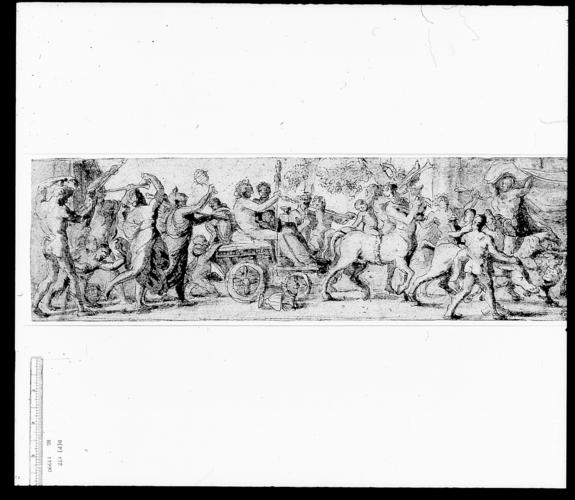The Triumph of Bacchus and Ariadne c.1627
Pen and ink with grey-brown wash over red chalk, on pale buff paper | 12.6 x 41.4 cm (sheet of paper) | RCIN 911990
-
A drawing of a frieze-like procession with Bacchus and Ariadne in a chariot at the centre.
Abandoned by her lover Theseus on the island of Naxos, Ariadne was discovered by Bacchus and his followers, who received her into the chariot of the god (Ovid, Metamorphoses, VIII, 176ff). Although not part of the narrative, the so-called Triumph of either Bacchus alone or Bacchus and Ariadne in a chariot, accompanied by a procession of nymphs, satyrs, centaurs, putti and all sorts of animals, was a popular decorative subject, often found on Roman sarcophagi. Poussin has adopted this frieze-like format, and several of the motifs of the drawing - the leopards leading the procession, the centaur before the chariot, the maenads following - are closely modelled on Roman sculpture.
The drawing is not connected with any known painting, and indeed such a long canvas would be very unusual (though Meleager and Atalanta hunting in the Prado and the Dance in honour of Priapus in São Paulo approach these proportions). The drawing is hard to date on account of the rather scratchy pen-nib which affected Poussin's usual fluency of line, but the figure types and the handling of the wash are close to works of the mid-late 1620s such as the Origin of Coral (RCIN 911984).
A painting in the Prado of Bacchus receiving Ariadne into his Chariot has in recent years been widely accepted back into Poussin's corpus. It has been generally dated to Poussin's first Roman years, around 1627, and thus in the same span of years as the present drawing. Though they are compositionally dissimilar, the figure types and treatment of space of the two have much in common. It is possible that, while not a preparatory study for the Madrid painting in the strictest sense, the drawing represents Poussin's first thoughts about the theme, as he attempted to come to terms with the antique tradition before remodelling the subject in his own manner.
Provenance
Cardinal Camillo Massimi (1620-1677); from whose heirs bought in 1739, for 300 scudi, by Richard Mead (1673-1754); probably presented to Frederick, Prince of Wales, by 1750.
-
Creator(s)
Acquirer(s)
-
Medium and techniques
Pen and ink with grey-brown wash over red chalk, on pale buff paper
Measurements
12.6 x 41.4 cm (sheet of paper)
Other number(s)
RL 11990Alternative title(s)
Il Choro di Bacco









